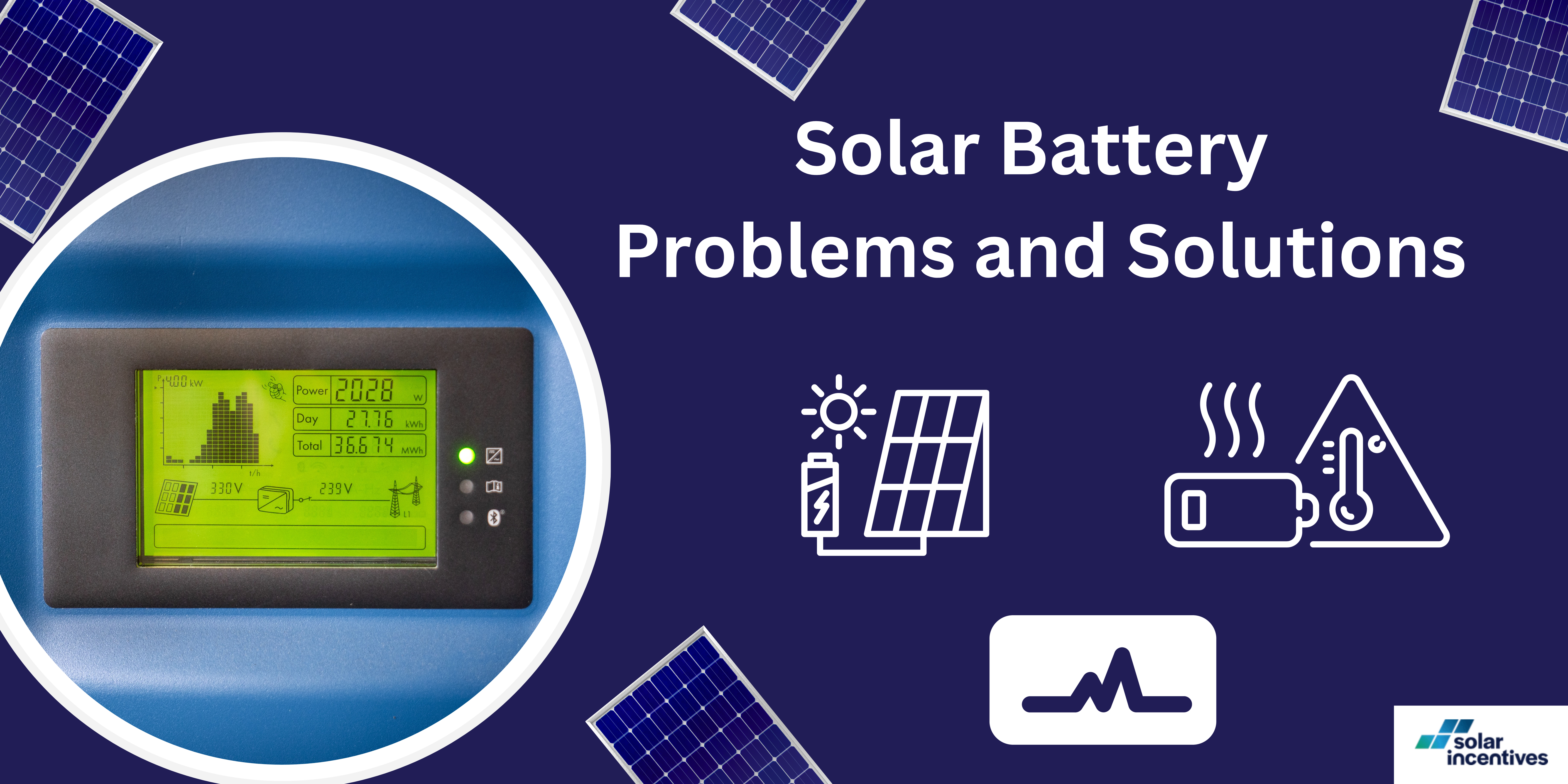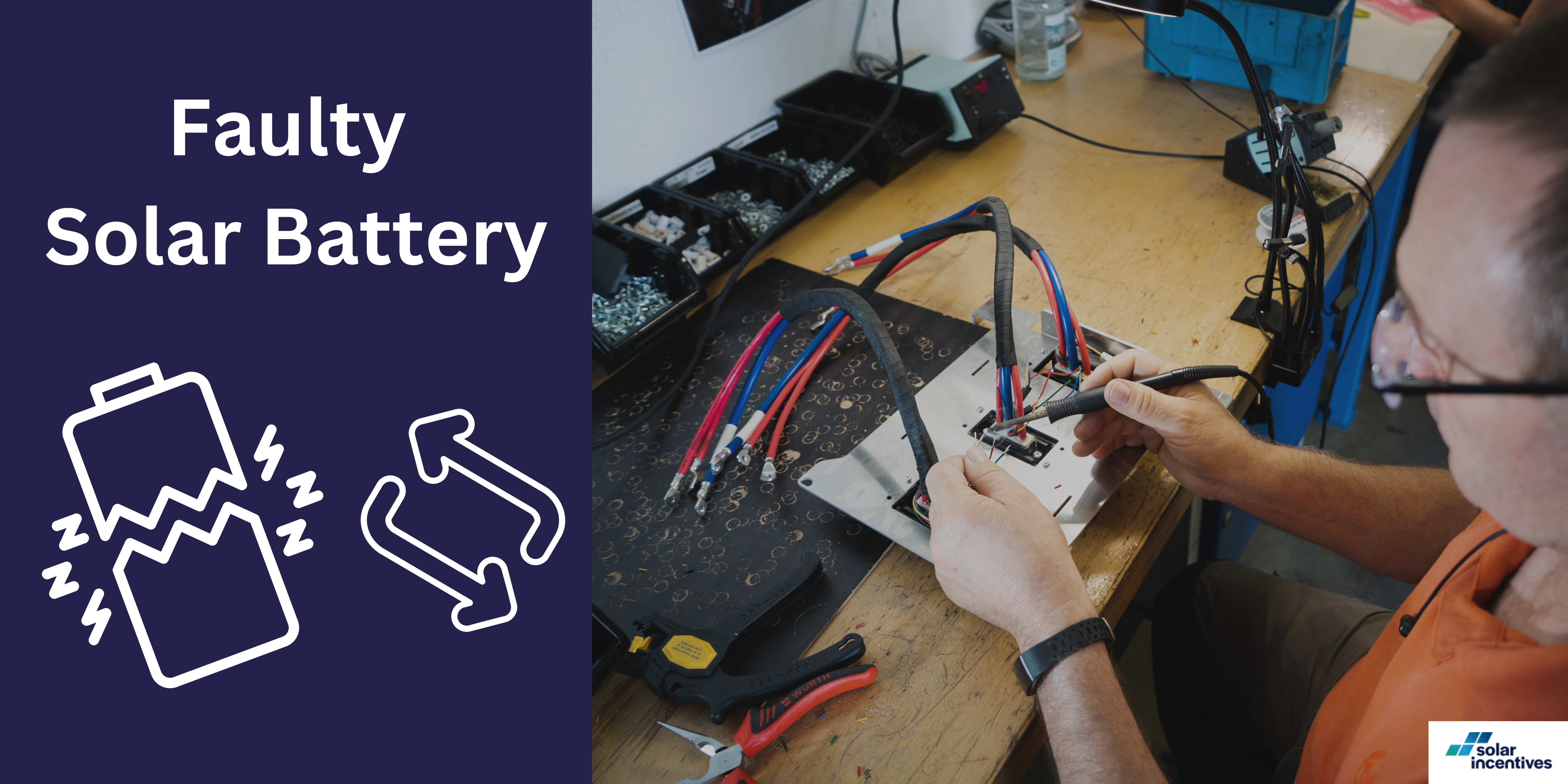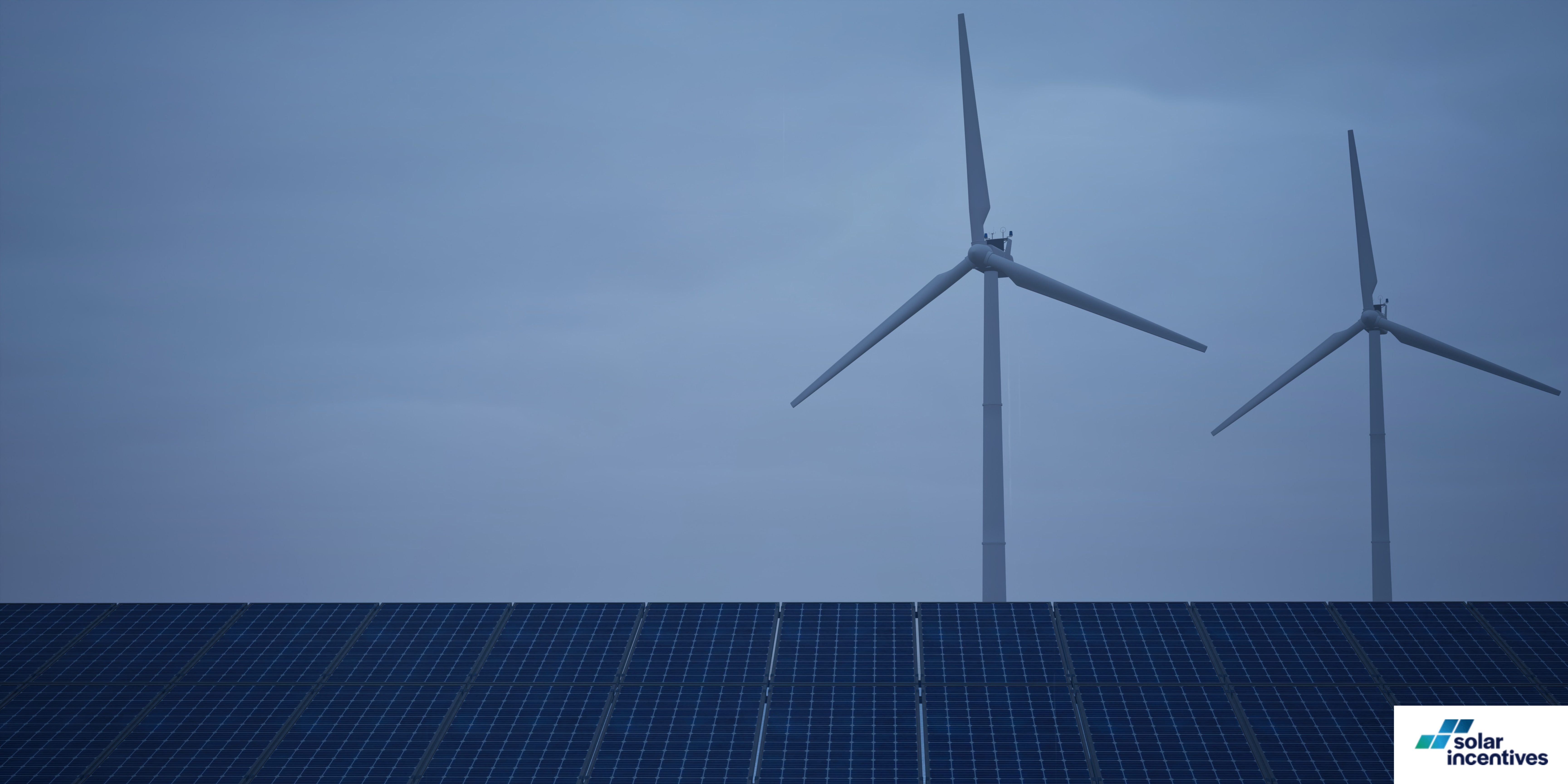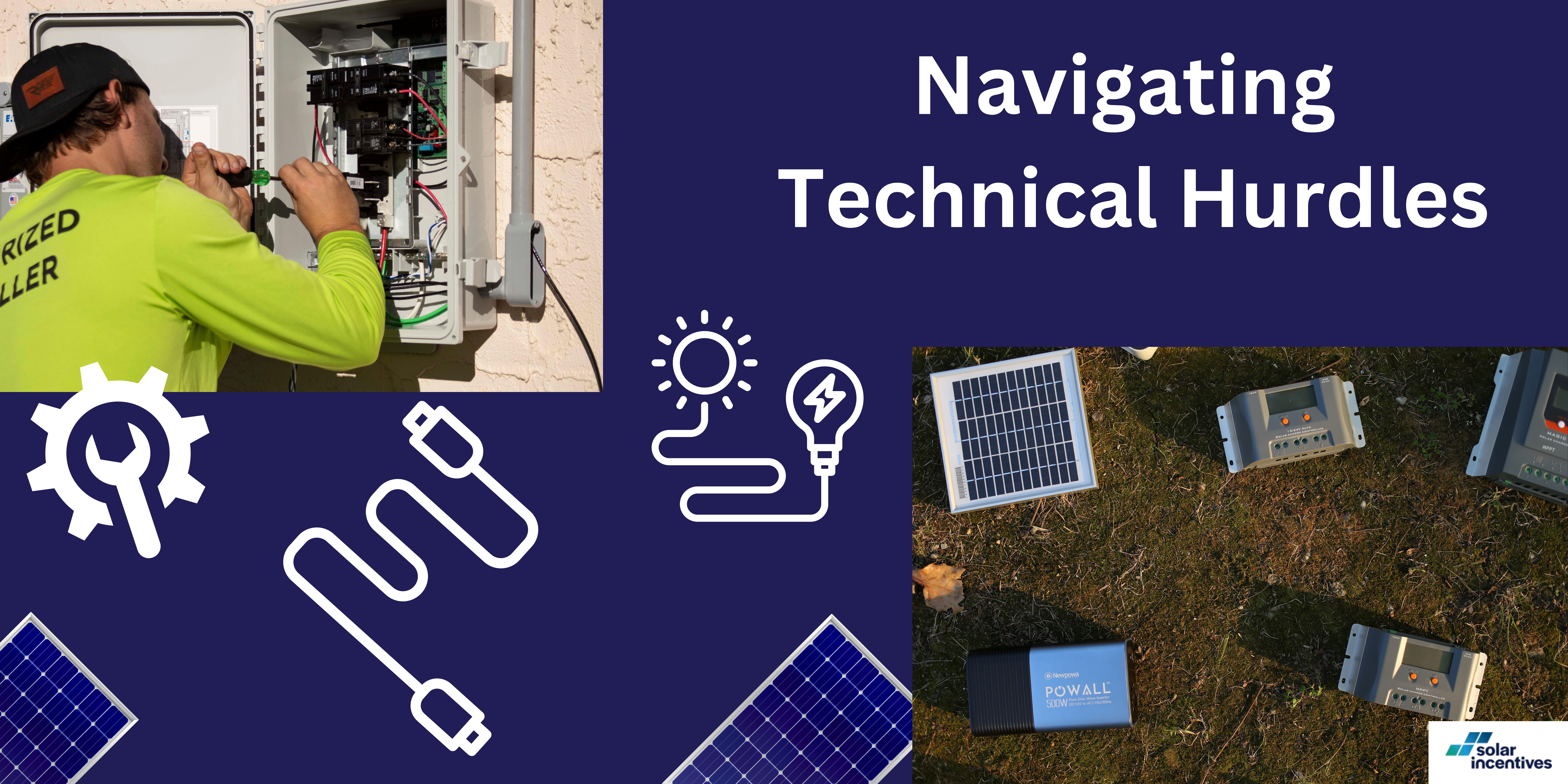Solar Battery Problems and Solutions

Steve Hill
Expert in Residential and Commercial Solar Solutions and Energy Efficiency
4 min read · 14th September 2023
Solar batteries have made it easier for us to store energy we harvest from the sun through solar panels, giving us a more earth-friendly way to power our homes.
But, like all technological advancements, they come with their set of challenges. In this post, we’ll delve into the common solar battery issues and offer efficient solutions to keep your system performing at its peak.
Faulty Battery

Sometimes the battery doesn’t work right.
If this happens, the best thing to do is to swap it out. Take out the damaged battery and put in a new one quickly.

The Battery Runs Out Quickly
Solar batteries can store a lot of energy, but they often run out quicker than other batteries. This could be due to some hidden issues.
For example, if you don’t charge them for a long time or if there’s a problem with the battery’s control system, they might drain fast.
To keep your battery healthy, don’t let it go entirely empty. But also, don’t leave it with only a little bit of energy; that can damage it from the inside.
It’s good to know when to charge and when to use your solar batteries. Doing this can help them last longer and save you money in the long run.
Other reasons they might run out of charge quickly include:
- The design might not hold as much energy as needed.
- Batteries get old over time.
- Sometimes, mistakes happen during installation that can cause short circuits.
- The battery might be used for things that need more power than it was designed for.
Battery Low Voltage
Low voltage often arises when a battery has been unused for a long period. Charging directly from the solar system can be tricky in this situation. It’s essential to check each battery’s voltage.
Inspect all batteries and identify the one with the lowest voltage. Use a charger to refill its power. For extended battery life, consider adding a battery balancer to the packs. This ensures longer-lasting performance.
Solar Controller Not Charging
Sometimes, even the newest or most advanced solar batteries won’t charge. It’s a frequent issue, but luckily, it’s often easy to address. Just follow the steps below for a solution.
If your solar controller isn’t charging:
- It might be due to an open circuit or damage in the equipment. In such cases, either repair or replace the affected device.
- Ensure the solar battery is positioned to effectively capture sunlight. If it’s in the shade, move it to a sunnier spot.
- If there’s a voltage mismatch or a processing error, enhance the booster and attach more photovoltaic panels in sequence.
Solar Battery Over-discharge

When a battery is connected to a load, it supplies current, leading to the battery discharging.
Discharge means the battery is losing its charge. If more current is taken from the battery, it empties quickly, causing the cell voltage to decrease.
Over-charging protection helps maintain the cell voltage. It stops the power output if the voltage falls below a set level.
Often, over-discharge protection kicks in before the battery is fully empty. This can happen if a device uses a lot of power, but not enough to cause a short circuit.
For protection against over-discharge and short circuits:
- Use a programmable electronic load to adjust resistance.
- Test overcharge protection with a programmable power supply.
- Consider a V722 or V44 battery.
- Connect the battery’s output to the programmable load.
Solar Battery Overheating
Quick charging or discharging can make the battery cells heat up. This excessive heat is due to the rapid reactions happening inside. Continually using solar batteries can also cause them to become too hot.
A sudden temperature rise is often a sign of overcharging. If this happens, it’s best to slow down the charge rate or stop charging altogether.
A simple solution? Pause the charging and let the battery rest for a few hours.
Weather Influence

The weather can greatly impact how your solar battery charges. For instance, a cloudy day can pose challenges for solar battery users.
To prepare for such days, it’s a good idea to charge your battery in advance – either a few hours earlier or even the day before.
This ensures that you have enough power stored, even when the sun isn’t shining brightly.
Issues with Solar Panels
Solar panels can sometimes be the reason behind battery charging issues. Here’s a breakdown of common faults related to solar panels and their solutions.
A. Hot Spot Damage
When a portion of a solar panel is regularly shaded or obstructed, it heats up more than the areas exposed to the sun, leading to the formation of hot spots.
These hot spots, when they reach a certain temperature, can cause the soldered connections of the battery to melt. This damage to the grid line can impair the entire solar module.
Statistics indicate that such hot spot damage can reduce the efficiency of a solar panel and might shorten its lifespan by up to 10%.
To avoid hot spot damage:
- Regularly check and maintain your installation.
- Opt for solar panels that feature corner drains to prevent dirt accumulation.
- Pick good solar panels with drainage corners and keep them out of shade. This helps your system work better.
B. Issues with Cracking
Tiny cracks in a solar cell can accelerate its power decay, impacting the overall life of the solar panel.
Cracks can get bigger if they’re put under constant pressure, leading to problems like hot spots.
While some cracks are easy to spot, others are harder to see but can greatly reduce how much power the panel makes.
To prevent the cracking problem:
- Be cautious of potential physical damages. Objects like balls or Frisbees, and even falling tree branches, can cause cracks. Ensure the surrounding environment is safe for the panels. Regularly trim trees that may pose a threat.
- Avoid cleaning the panels with a hose. The panels’ glass is sensitive to thermal shocks. Direct sunlight combined with cold water can induce cracks. It’s best to clean them professionally, especially during peak sun hours.
Navigating Technical Hurdles

The performance and cost of a solar PV battery are largely influenced by three pivotal metrics. These key indicators are capacity (also known as energy density), stability, and overall efficiency.
Capacity/Energy Density
The energy storage capability, or in technical terms, the ‘energy density’ of a PV battery, is a central challenge.
A typical design for these battery systems involves a flat structure. This structure layers battery components like the anode, cathode, and separator directly onto the PV module.
To address this challenge, the use of materials with a high capacity is often recommended.
For instance, batteries made from silicon-NMC can offer an energy density of up to 400 Wh/kg. It’s worth noting that silicon is a widely used material in PV technology.
Overall Efficiency
In lab tests, a PV battery system with three electrodes has about 7.61% efficiency.
If you consider a two-electrode integrated system, this number drops even further to 0.08 percent, and for a redox flow system, it’s 3.2 percent.
These numbers might make you wonder if such batteries are even commercially viable.
Efficiency is about how well the PV turns light into electricity and how the battery stores it. Combined systems work differently than single cells or just solar batteries.
To boost efficiency, choose the right battery materials and focus on storage. The battery’s parts, like electrodes and electrolytes, play a big role in this.
Also, the way a solar battery behaves during charging and discharging plays a role in its storage efficiency.
Stability
Here’s another challenge – stability. Stability means how the battery performs in sunlight, its effect on the environment, and its chemical reactions. The battery’s materials play a big role in this. Improvements in the battery or the solar part help, but a combined approach is best.
Another stability issue is the heat coming from the solar part, which affects the battery’s thermal response.
How can we counteract this? By focusing on battery compositions that are tolerant to high temperatures. In this context, solid electrolytes emerge as a promising solution.
Conclusion
While solar batteries bring us closer to a sustainable future, it’s essential to understand and address their challenges.
By being proactive and informed, you can extend your solar battery’s lifespan, ensure optimal performance, and get the most out of your investment.
Facing more complex issues? Don’t hesitate. Reach out to experts at Solar Incentives for specialized guidance.
Article By
Steve Hill
Steve Hill has a rich background in the solar energy sector and is dedicated to empowering consumers with knowledge, particularly in residential and commercial solar solutions, solar batteries, and energy efficiency products.
Steve enjoys sharing his wealth of experience, offering practical advice, and learning about the latest trends and innovative solutions in the world of solar energy.

